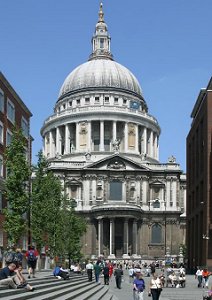St Paul's Cathedral

Dominating the skyline on the north bank of the Thames, this imposing structure, also known as London Cathedral, was designed by Sir Christopher Wren. and is the latest in a series of religious buildings to have occupied this site.
On Sunday Sept. 2, 1666, St Paul's Cathedral was burned to the ground in a fire that destroyed over four-fifths of London. Charles II commissioned Christopher Wren, designer of 53 London churches, to construct a model for a replacement cathedral.
In 1675, Wren's third model was completed and accepted. Although work began soon after, the building took over 35 years to complete. Finally, in 1710, St Paul's cathedral was completed, and is the fifth religious structure to have stood on this site (the first was a Roman temple dedicated to Diana).
Today, the cathedral has relatively few monuments (as compared to Westminster Abbey, for example) and was entirely free of them until 1795, when Bacon's monument to John Howard, a pioneer of prison reform, was erected there. St. Paul's Cathedral is the seat of the Bishop of London, and was the site of the royal wedding of Charles, Prince of Wales, and Lady Diana Spencer in 1981.
Monday to Saturday from 8.30am until 4pm.
Open for services only on Sundays.
Location
St Paul's Cathedral
Ludgate Hill
The City
EC4M 8AD
Telephone
+44 (0)20 7236 4128
Getting There
St Paul's Underground station is a five minute walk from the Cathedral. Mansion House, Cannon Street and Blackfriars stations on the District and Circle Line are a slightly longer walk.
Nearest Tube / Rail Station
St. Paul's
Bus Routes
4, 11, 15, 23, 25, 26, 100, 242
Access
Access for wheelchair users and visitors with mobility issues is via the entrance on the South Side. A lift gives access to the Cathedral floor and the Crypt.
